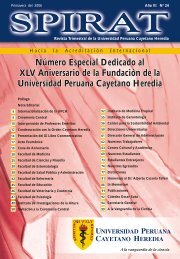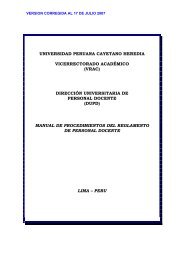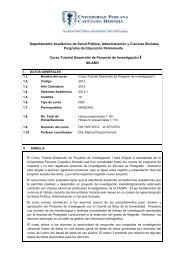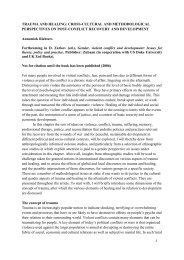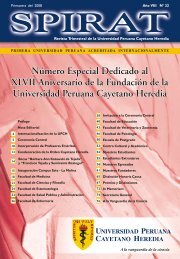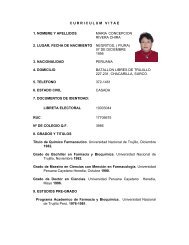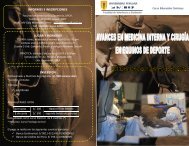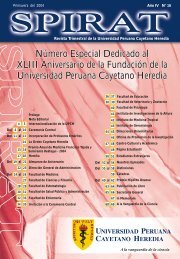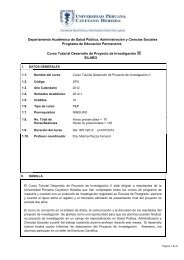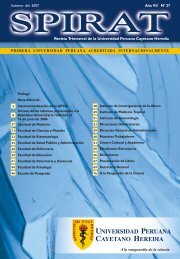Herbivore-induced, indirect plant defences - UPCH
Herbivore-induced, indirect plant defences - UPCH
Herbivore-induced, indirect plant defences - UPCH
You also want an ePaper? Increase the reach of your titles
YUMPU automatically turns print PDFs into web optimized ePapers that Google loves.
94G. Arimura et al. / Biochimica et Biophysica Acta 1734 (2005) 91–111mechanical damage which, in some <strong>plant</strong> species, is reachedonly after continuous wounding and which triggers thetypical repertoire of defence responses caused by elicitors.cDNA was isolated from a species of tobacco, encoding amitogen-activated protein kinase (MAPK), whose transcriptbegins to accumulate in the leaves 1 min after a singlemechanical wounding event [17]. This protein kinase(WIPK) is considered essential for JA formation and JA<strong>induced</strong>responses in tobacco, since transgenic <strong>plant</strong>s inwhich WIPK has been silenced show impaired accumulationof JA and MeJA after wounding [17]. In contrast, the loss ofWIPK function in this transgenic line resulted in anincreased accumulation of salicylic acid (SA) and its sugarconjugate salicylic acid h-glucoside after wounding; however,such accumulation was not observed in wild-type<strong>plant</strong>s. The signalling pathways associated with JA and SAare generally thought to cross-communicate antagonistically(see below). Moreover, WIPK has also been reported toelicit the transcription of a gene for a N-3 fatty aciddesaturase (FAD7), which catalyses the conversion oflinoleic acid to linolenic acid, a precursor of JA [18]. Thus,WIPK may be an early activator of the octadecanoidpathway. WIPK and the SA-<strong>induced</strong> protein kinase (SIPK)were found to share an upstream MAPKK, NtMEK2 [19],and to interact with the calmodulin (CaM)-binding MAPKphosphatase (NtMKP1) [20]. Both kinases are commonlyinvolved in wound-mediated defence responses in tobacco[19,21,22]. If the MAPK cascades in tobacco were onlyinterlinked as described above, an active mutant of theupstream kinase of SIPK (NtMEK2 DD ) should haveincreased the accumulation of JA and MeJA, but it didnot [23]. Instead, ethylene was assumed to be involved in<strong>plant</strong> defence responses mediated by the NtMEK2-SIPK/WIPK pathway. This discrepancy may be not only due tothe complicated interactions of protein kinase/phosphatasecascades, but also to cross-talk between the JA-, SA-, andethylene-signalling pathways (see below). Since calciumdependentprotein kinases (CDPKs) are regularly involvedin signal transduction of a variety of biotic and abioticstresses [24], their involvement as active protein cascades inherbivore/wound responses cannot be excluded. CDPKscompose a large family of serine/threonine kinases in <strong>plant</strong>s(for example, 34 members in Arabidopsis) [25,26]. JA hasbeen reported to affect CDPK transcript and activity inpotato <strong>plant</strong>s [27].A transgenic Arabidopsis line in which the expressionlevel of phospholipase Da (PLDa) is suppressed has beenreported to show a decreased wound-<strong>induced</strong> accumulationof phosphatidic acid and JA, as well as JA-inducibletranscript activation [28]. Curiously, this loss-of-functionmutant also featured decreased expression of the genecoding lipoxygenase2 (LOX2) but not of any other geneinvolved in the octadecanoid pathway. LOX2 is one of thekey enzymes for the wound-<strong>induced</strong> synthesis of JA inchloroplasts [29]. Therefore, PLD may specifically regulateLOX2 upstream of the octadecanoid pathway that leads toJA. In addition, the involvement of phospholipase A (PLA),which mediates the release of linolenic acid from cellmembranes and is inducible by wound stimuli, has been alsoproposed for tomato (Lycopersicon esculentum) and otherspecies [30].Altogether, early and secondary cell signalling forherbivore-<strong>induced</strong> <strong>plant</strong> responses comprise: (1) the receptionof an extracellular signal(s) such as high- or lowmolecularweight factors from the herbivore (e.g., FACs),(2) V m depolarization and an intracellular calcium influx, (3)the activation of protein kinase/phosphatase cascades, and(4) the release of linolenic acid from the cell membrane andsubsequent activation of the octadecanoid pathway whichleads finally to the synthesis of JA and other oxylipins.However, multiple signals, signal circulation by, forexample, protein phosphorylation/dephosphorylation, andfeedback regulation of signalling and metabolic pathwaysare likely to complicate the understanding of the accuratemechanism.2.3. Oxylipin, SA, and their antagonismJA and SA function as signalling molecules, whichmediate <strong>induced</strong> <strong>plant</strong> responses toward herbivory andpathogen infection, resulting in the activation of distinctsets of defence genes [31–33]. Besides free JA, also aconjugate with the amino acid isoleucine may be involvedin signalling [34,35], but the significance of suchconjugates still remains to be established. Inhibiting theperformance of JA or SA obviously renders <strong>plant</strong>s moresusceptible to herbivore damage and pathogen infection[36–39]. JA and SA act antagonistically, and are bothrequired for the <strong>induced</strong> response following herbivorefeeding or pathogen attack [40–44]. For instance, thegraduated increase of SA accumulation in Lima beanleaves treated with alamethicin (ALA), a potent fungalelicitor of <strong>plant</strong> volatile emission, interferes with steps inthe biosynthetic pathway downstream of 12-oxophytodienoicacid (OPDA), thereby reducing the rapid accumulationof JA (~40 min) [41] and, finally, the biosynthesisand emission of all JA-linked volatiles. On the other hand,enhanced levels of OPDA selectively induce the emissionof the C 16 -tetranorditerpene 4,8,12-trimethyltrideca-1,3,7,11-tetraene (TMTT) in Lima bean [45]. Consequently,the treatment of Lima bean leaves with variousamounts of JA and SA caused the emission of characteristicblends of volatiles including TMTT, which stronglyattracted the carnivorous natural enemies of spider mites[40,46,47]. Hence, JA and SA pathways may vie with eachother to control and coordinate <strong>induced</strong> <strong>defences</strong>, since theemission of characteristic blends of herbivore-<strong>induced</strong>volatiles from attacked <strong>plant</strong>s strongly depends on thedelicate balance between JA and SA [41]. Alternatively,both pathways may play a role in discriminating insectbiting from mechanical wounding and thus may be a kindof filter that prevents unnecessary defence activation.




